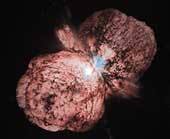|
COMETS EARTH JUPITER KUIPER BELT MARS MERCURY METEORITES NEPTUNE OORT CLOUD PLUTO SATURN SOLAR SYSTEM SPACE SUN URANUS VENUS ORDER PRINTS
PHOTO CATEGORIES SCIENCEVIEWS AMERICAN INDIAN AMPHIBIANS BIRDS BUGS FINE ART FOSSILS THE ISLANDS HISTORICAL PHOTOS MAMMALS OTHER PARKS PLANTS RELIGIOUS REPTILES SCIENCEVIEWS PRINTS
|
Related Document
Download Options
A huge, billowing pair of gas and dust clouds are captured in this stunning NASA Hubble Space Telescope image of the supermassive star Eta Carinae. Using a combination of image processing techniques (dithering, subsampling and deconvolution), astronomers created one of the highest resolution images of an extended object ever produced by Hubble Space Telescope. The resulting picture reveals astonishing detail. Even though Eta Carinae is more than 8,000 light-years away, structures only 10 billion miles across (about the diameter of our solar system) can be distinguished. Dust lanes, tiny condensations, and strange radial streaks all appear with unprecedented clarity. Eta Carinae was observed by Hubble in September 1995 with the Wide Field Planetary Camera 2 (WFPC2). Images taken through red and near-ultraviolet filters were subsequently combined to produce the color image shown. A sequence of eight exposures was necessary to cover the object's huge dynamic range: the outer ejecta blobs are 100,000 times fainter than the brilliant central star. Eta Carinae was the site of a giant outburst about 150 years ago, when it became one of the brightest stars in the southern sky. Though the star released as much visible light as a supernova explosion, it survived the outburst. Somehow, the explosion produced two polar lobes and a large thin equatorial disk, all moving outward at about 1.5 million miles per hour. The new observation shows that excess violet light escapes along the equatorial plane between the bipolar lobes. Apparently there is relatively little dusty debris between the lobes down by the star; most of the blue light is able to escape. The lobes, on the other hand, contain large amounts of dust which preferentially absorb blue light, causing the lobes to appear reddish. Estimated to be 100 times more massive than our Sun, Eta Carinae may be one of the most massive stars in our Galaxy. It radiates about five million times more power than our Sun. The star remains one of the great mysteries of stellar astronomy, and the new Hubble images raise further puzzles. Eventually, this star's outburst may provide unique clues to other, more modest stellar bipolar explosions and to hydrodynamic flows from stars in general. Photo Credit: Jon Morse (University of Colorado), and NASA |
